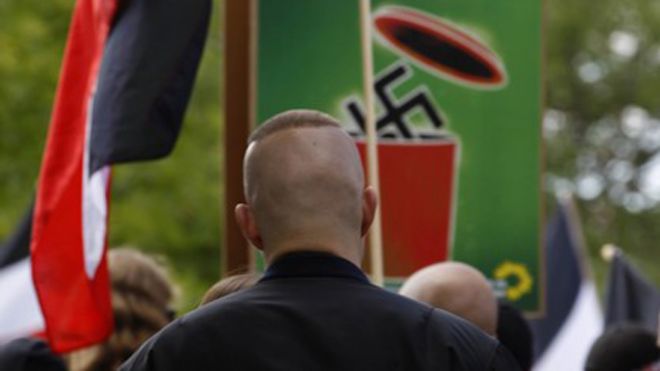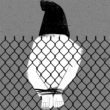During the 2006 World Cup in Germany, Uwe-Karsten Heye, spokesman of former German Chancellor Gerhard Schröder, cautioned visitors “of another skin color” to stay away from eastern Germany. “It is possible,” he said, that you “wouldn’t get out alive.”
His statement sparked outrage, but certain eastern parts of the country are indeed widely known in Germany by their neo-Nazi name. They are called “Nationally Liberated Zones.”
That means they have been “cleansed” of so-called foreigners.
| German leaders and media expressed shock that neo-Nazis exist but their terrorism is widely known — and even encouraged. |
In fact, at the time of Heye’s statement, members of the National Socialist Underground (NSU), a right-wing terrorist group, had been living in Nationally Liberated Zones for years. They shot to death a police officer as well as nine men of Turkish and Greek descent. They set off nail bombs in Cologne and robbed numerous banks to fund their cleansing operations.
The group was exposed in November 2011 when two members, Uwe Mundlos and Uwe Böhnhardt, killed themselves after a bank robbery gone awry. Police found the weapon used in the murder of nine men with the bodies of Mundlos and Böhnhardt.
Now a member of the National Socialist Underground is being tried in Munich in a high-profile case that began in May. Beate Zschäpe is accused of involvement in 10 murders and of conspiring to “criminal acts dangerous to public safety” to intimidate the public and “wreak major damage to the state.”
Authorities allege that she abetted the group, rented getaway vehicles and administered stolen money over more than a decade. After Mundlos and Böhnhardt were found dead, Zschäpe set their apartment on fire, then went underground for a time before turning herself in. While on the run, she released videos within which the NSU took responsibility for the murders. Three others are being tried in Munich for aiding the group.
All of them grew up in the 1990s and have been active neo-Nazis for years. Nationalism and racism surged after reunification all across Germany. With the fall of the Berlin Wall, the perceived injustice of postwar division was considered rectified, and the new “pride to be German” ethos reconnected to a deeply racist understanding of “Germanness.”
Given that the NSU is widely known to intelligence authorities, how did it evade scrutiny for years? That’s one of the questions being asked. Germany’s federal domestic intelligence chief resigned in 2011 after his agency destroyed documentation of its work with paid neo-Nazi informants. For years, antifascist groups had warned that the agency’s practice of maintaining a web of paid informants within neo-Nazi circles was in fact funding the extreme right. Moreover, a parliamentary inquiry committee found evidence of more missing documentation.
It gets worse. An actual Verfassungsschutz agent was present at the scene in 2006 when the NSU murdered a Turkish German café owner. The agent was transferred to a desk job while details emerged about his nickname: “Little Adolf.” Unconfirmed reports put Little Adolf at three or more neo-Nazi murder scenes.
Politicians expressed shock and spoke of disgrace, but there seems little willingness to look deeper. The actual problem of widespread racism in Germany is still being denied.
| At issue is the paradox of national identity implicit in the existence of Turkish Germans and others. |
Only a few decades ago, the late black German activist and poet May Ayim had her dissertation project, which investigated racism, rejected at a German university. After 1945, she was told, there was no such thing as racism. Accordingly, the term for racism has been for the longest time “hostility towards foreigners.” The idea that victims of racist insults and attacks are foreigners reveals the underlying dictum: a concept of nationality in which the existence of black Germans, Turkish Germans, Jewish Germans and others is an oxymoron.
The envisioned norm is white, Christian, and elusively “German-German.” So it’s not surprising to see murder investigations that focus on victims and betray racist undertones.
For a decade, investigators assumed the murder victims had mafia connections, likely involving drugs. The nail bombings that wounded dozens in Cologne were seen in the same light. In all cases, the families of victims were interrogated for years in order to uncover a (non-existent) link to organized crime. The murders were furthermore trivialized when they were dubbed “The Döner-Killings” after the Turkish kabob meat.
After the NSU was exposed in 2011, German Chancellor Angela Merkel was not the only one to express shock. German media reported a national “state of shock” — a remarkable and telling declaration given two decades of neo-Nazi violence and bloodshed.
The trial in Munich may last two years. While “historic,” none of these proceedings are likely to acknowledge that the NSU emerged from the commonly held notion of German nationality that gained deadly momentum after reunification in the 1990s.
Annette Seidel-Arpaci is a Visiting Research Scholar in the School of Fine Art, History of Art and Cultural Studies at the University of Leeds in the UK.







0 Comments